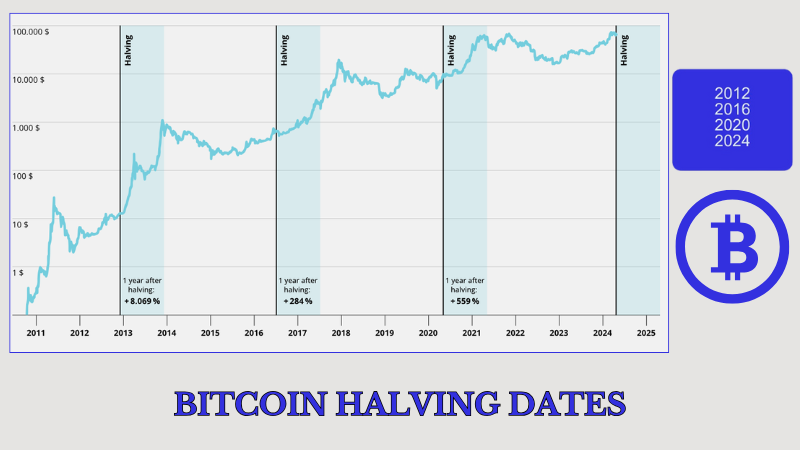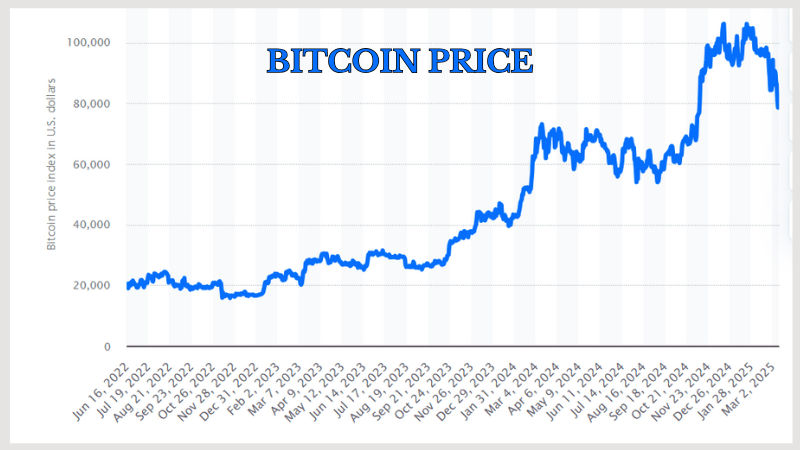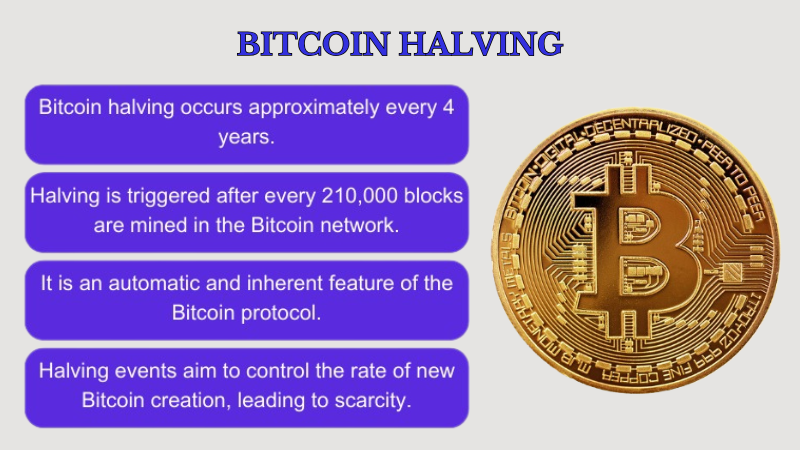A key aspect driving Bitcoin’s long-term price development is the halving of Bitcoin. It helps create disinflationary pressure on the cryptocurrency. The following sections offer more details, enabling you to understand Bitcoin halving and its benefits.
Thanks to the inventiveness of its design, Bitcoin is an industry leader. A number of factors have allowed it to become a famous and popular type, including:
- Economic inducements paired with advanced cryptography.
- A hard-coded monetary policy.
- An innovative consensus protocol.
How Does Halving of Bitcoin Work?
Bitcoin halving occurs automatically and doesn’t depend on a central authority or third party. When transactions take place in the Bitcoin network, they’re stacked into block groups, and miners get rewards for validating transactions successfully.
For every 210,000 blocks mined, the Bitcoin protocol reduces the reward automatically, which miners earn to half. To date, three BTC halvings have occurred.

2012, when 210,000 Blocks were Mined
Bitcoin halving history starts in 2012 year. This was the first Bitcoin halvening process. During this time, there were numerous concerns about Satoshi’s economics, including how it would affect Bitcoin expansion.
Would it spell the end of the digital cryptocurrency or curb inflation? Some argued that the halving and finite supply events could result in deflation and a reduction in the Bitcoin value. Others believed that it could boost scarcity and Bitcoin halving effect on price may be positive.
Following the 28th November 2012 halving, which reduced the digital currency’s Bitcoin block halving reward from 50 BTC to 25 BTC, the value of a single coin shot up from £12 to £1,032 in less than a year, an increase of more than 8,500%. A combination of factors was behind this significant increase in value, including:
- Scarcity perception as a result of the halving event
- Increasing Bitcoin acceptance as a legitimate cryptocurrency type
- Ever-growing demand from speculators and investors
The reduced block reward also showed that fewer Bitcoins were being manufactured, further contributing to the increase in Bitcoin value. In 2012, 120,000 blocks were already mined, and half of the 10.5 million coins in circulation had been released.
2016, when 420,000 Blocks were Mined
The crypto community enthusiastically anticipated the second time Bitcoin halving date. Additionally, Bitcoin was significantly gaining popularity and acceptance among investors, leading to a short-time value increase before the 9th July halving Bitcoin date.
The Bitcoin block reward halving was cut in half on this data. It was the second time in history once the 420,000th block was attained. The digital currency was trading at about £651, during this time.
The cryptocurrency experienced a free fall some weeks after halving. But this was a pause prior to an exponential increase when the value of a single coin attained an all-time high of £20,089,526 a few days after halving.
2020, when 630,000 Blocks were Mined
While the coronavirus caused the value of the cryptocurrency to crash in March, Satoshi’s economics proved to be remarkable. The value of Bitcoin has been increasing since then.
On 11th May, at the 630,000th block, the reward was cut in half and during this time, the cryptocurrency was trading for approximately £8,780 a coin. A year, and six months later, the cryptocurrency reached a high of approximately £66,000.
The 4th Bitcoin Halving Event (2024)
The 4th Bitcoin halving occurred on April 20, 2024, at block number 840,000. This event reduced the block reward from 6.25 BTC to 3.125 BTC, further decreasing the rate at which new Bitcoins are introduced into circulation.
The Next Bitcoin Halving (2028): What to Expect
The next Bitcoin halving is expected around March 28, 2028, when miners reach block 1,050,000. At that point, the block reward will drop from 3.125 BTC to 1.5625 BTC, reducing the number of new Bitcoins entering circulation.
The Effects of Bitcoin Halving
The three previous halving Bitcoin events have been strongly associated with an increase in value and this is because the reduced new digital coin creation rate causes scarcity, increasing demand and value.
It’s vital to keep in mind that a variety of factors influence market dynamics, making price movement a complicated process.

A closer look at the previous three BTC halving events indicates that a significant value increase usually starts after between six and twelve months. Before a halving event, Bitcoin price tends to increase as investors anticipate a value rally post-halving.
If you are considering investing in Bitcoin, it would be helpful to read Bitcoin price prediction.
What exactly is Bitcoin Halving?
Bitcoin halving happens about every four years. It cuts the rewards miners get for verifying transactions in half, making Bitcoin more scarce over time. This helps control supply and can impact Bitcoin’s price.
Here’s a quick breakdown:
✔️ Happens every four years – After every 210,000 blocks are mined, miner rewards are cut in half.
✔️ Past halvings – The first was in 2012, the second in 2016, the third in 2020, and the most recent in 2024.
✔️ Miners earn less – Since rewards drop, some miners may find it less profitable to keep mining.
✔️ Why it matters? – With fewer new Bitcoins entering circulation, scarcity could drive up demand and price.
Bitcoin halving plays a big role in Bitcoin’s long-term value. It’s why many compare Bitcoin to gold—limited supply, increasing scarcity, and the potential for price growth.
Bitcoin Halving in Details
Miners who’re individuals use computers that provide solutions to mathematical problems to develop new blocks, allow new coins to circulate, and get rewards for their efforts. The first block reward for miners within the Bitcoin network was 50 BTC.
Bitcoin’s reward has steadily decreased over time due to a built-in halving rule in its code. While the exact halving dates aren’t fixed on a calendar, they follow a consistent schedule.

The provision states that the digital currency’s block reward should be cut in half permanently, approximately every 210,000 blocks. Or after every four years. This is done to control the amount of new digital coins entering the Bitcoin Network.
Currently fixed at 21 million coins, Bitcoin supply and this amount are based on computations you can access in the cryptocurrency’s whitepaper.
Once the 21 million bitcoins are generated in the Bitcoin network, the total supply will be reached, and no additional bitcoins will be created.
Final Thoughts: Is Halving Bad or Good?
Bitcoin halving has already proven to be good. It’s one of the key economics enticing investors to invest in this cryptocurrency. While fiat currencies are bound to be inflationary due to their ever-growing supply, Bitcoin is capped at a maximum distribution.
That means the halving process minimises its rate of inflation. Halving of Bitcoin is considered an excellent economic model. The primary reason behind this is that it triggers disinflationary pressure on the cryptocurrency. And this enables it to increase in value.
FAQs About Halving of Bitcoin
What is Bitcoin halving?
Bitcoin halving reduces the creation rate of new bitcoins, happening about every four years.
Why does Bitcoin halving happen?
To control the supply of Bitcoin and maintain scarcity, mimicking the scarcity of precious metals like gold.
What impact does halving have on Bitcoin's price?
Historically, it has led to increased price volatility, with potential for both short-term spikes and long-term value appreciation.
How does halving affect miners?
It reduces the reward miners receive for validating transactions, impacting their profitability.
What is the significance of the 210,000 blocks in the halving Bitcoin?
It marks the four-year cycle where Bitcoin’s total supply decreases by half.